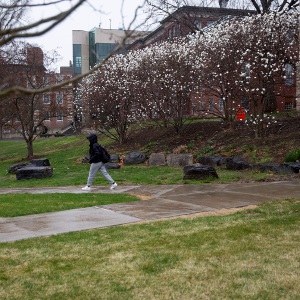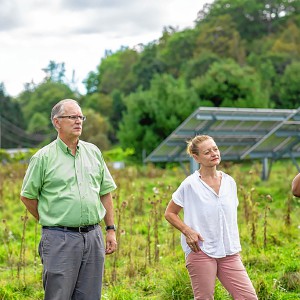Dartmouth researchers project impact of wetter winters on New England rivers
| Published: 04-25-2023 6:02 PM |
HANOVER — A team of Dartmouth College researchers has modeled the impact less snow and more rain in the Northeast might have on the future of the region’s waterways.
Climate change has thrown the main drivers of stream water levels in flux, according to the group’s study. The region has experienced the largest increase in extreme precipitation events over the past quarter-century of any in the country, and this past winter, warmer-than-usual temperatures drove a below-normal snow pack.
“This means peak streamflow is also projected to happen earlier as the center of snow pack season shifts up,” said Jonathan Winter, an associate professor of geography at Dartmouth and the senior author of the study.
When rain falls on soil already saturated with water, the excess runs off, sometimes into rivers and streams, causing higher streamflow. Wet, over-burdened soil was a contributing factor to the multiple deaths and the billions of dollars in damage wrought by Tropical Storm Irene in 2011.
With increases in precipitation projected for the end of the century, Winter urges caution about increased flooding in already vulnerable places.
While his group’s research made predictions for the years 2070 to 2099, that far-flung modeling leaves a trail. “Whatever kind of impacts that they show for that time, trace the path on the way there,” Winter said. “By the 2050s, you’ll have about half of the changes that we project.”
To keep people safe and prevent property damage, larger setbacks for housing and buildings in floodplains will be needed, Winter said. So will more warning systems like the Northeast River Forecasting Center, a water-level monitoring system operated by the National Weather Service.
Winter sees the findings of the study particularly relevant to planning municipal infrastructure projects.
Article continues after...
Yesterday's Most Read Articles
 Zantop daughter: ‘I wish James' family the best and hope that they are able to heal’
Zantop daughter: ‘I wish James' family the best and hope that they are able to heal’
 Crowd turns out to honor late Ascutney Fire Chief Darrin Spaulding
Crowd turns out to honor late Ascutney Fire Chief Darrin Spaulding
 A Life: For Kevin Jones ‘everything was geared toward helping other people succeed’
A Life: For Kevin Jones ‘everything was geared toward helping other people succeed’
 Pick a sport and Pete DePalo’s has probably officiated it over the past 40-plus years
Pick a sport and Pete DePalo’s has probably officiated it over the past 40-plus years
 Out & About: Vermont Center for Ecostudies continues Backyard Tick Project
Out & About: Vermont Center for Ecostudies continues Backyard Tick Project
“Any time you’re getting high stream flow, you’re worrying about scouring of bridges and culverts and washing out roads,” he said. High stream flow also carries more dirt and debris.
“Whatever you’re washing off — salt from the winter, manure from neighboring fields or runoff from cities — that all goes into the river and gets transported,” Winter said. “The more stream flow you have, the more you can mobilize. There could be some more water-quality issues.”
Along with four other watersheds across the region, the research focused on the White River, using information collected on the river by U.S. Geological Survey stream gauges, including one in West Hartford; historical climate data going back more than 100 years; and snow depth observations from the Northeast Regional Climate Center.
But the future of snowfall, dwindling each year, is hard to predict.
“Still, all put together, I do expect there to be higher stream flows in the winter,” Winter said. “But it will be driven by rain instead of snow.”
Frances Mize is a Report for America corps member. She can be reached at fmize@vnews.com or 603-727-3242.

 How a hurricane and a cardinal launched a UVM professor on a new career path
How a hurricane and a cardinal launched a UVM professor on a new career path Art Notes: After losing primary venues, JAG Productions persists
Art Notes: After losing primary venues, JAG Productions persists  Over Easy: Marvels in the heavens, and in the yard
Over Easy: Marvels in the heavens, and in the yard 
